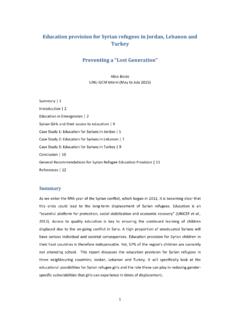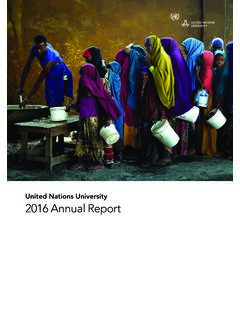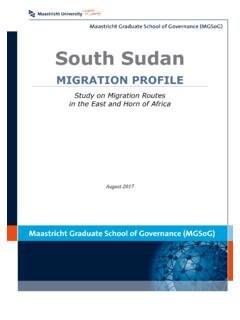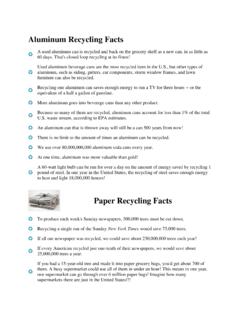Transcription of THE GLOBAL E-WASTE MONITOR - United Nations University
1 THE GLOBALE- waste MONITOR2014 Quantities, flows and resourcesCOPYRIGHT AND PUBLICATION INFORMATIONC ontact information:For enquiries please contact the corresponding author via cite this publication asBald , , Wang, F., Kuehr, R., Huisman, J. (2015), The GLOBAL E-WASTE MONITOR 2014, United Nations University , IAS SCYCLE, Bonn, Germany. ISBNP rint: 978-92-808-4555-6 Electronic: 978-92-808-4556-3 DISCLAIMERU nited Nations University (UNU) is an autonomous organ of the UN General Assembly dedicated to generating and transferring knowledge and strengthening capacities relevant to GLOBAL issues of human security, development, and welfare. The University operates through a worldwide network of research and training centres and programmes, coordinated by UNU Centre in Tokyo. The designations employed and the presentation of the material in this publication do not imply the expression of any opinion whatsoever on the part of the United Nations University concerning the legal status of any country, territory, city or area or of its authorities, or concerning delimitation of its frontiers or boundaries.
2 Moreover, the views expressed do not necessarily represent those of the United Nations University , nor does citing of trade names, companies, schemes or commercial processes constitute book is licensed by the United Nations University under a Creative Commons Attribution-Noncommercial-Share Alike IGO License. Please take the time to learn more about Creative Commons. Your fair use and other rights are in no way affected by the by:Bald , , Wang, F., Kuehr, R., Huisman, J. The GLOBAL E-WASTE Monitor20148uantities ows and resourJes4 ForewordE- waste , or waste electrical and electronic equipment, is an emerging and fast-growing waste challenge to waste management in both developed and developing countries. Rapid technology innovation and ever-shortening product lifespans are among the factors contributing to the growing amount of E-WASTE . Over the past two decades, policymakers, producers and recyclers in various countries have Dz dz and process it in professional treatment facilities.
3 Unfortunately, despite these efforts, the collection and state-of-the-art treatment of E-WASTE is limited, and most Nations are still without such E-WASTE management systems. There is a large portion of E-WASTE that is not being collected and treated in an environmentally-sound manner. Further, some of the world s techniques are often used to extract materials and components. These backyard techniques pose dangers to poorly protected workers and the local natural environment. GLOBAL trading of electronics and substandard recycling in developing countries has led to environmental catastrophes in places like Guiyu, China and Agbogbloshie, Ghana, to name two examples. Many studies have touched multiple aspects of E-WASTE , such as pollution and toxicity, recycling technologies and best policies for the collection and treatment of this waste stream. However, as of yet there is no study that monitors the GLOBAL quantity of E-WASTE by applying a harmonised measurement method for all countries.
4 Many estimated quantities of E-WASTE As a worldwide leading institute in E-WASTE research, the United Nations University (UNU), MONITOR of quantities of GLOBAL E-WASTE using a harmonised methodology. The results are based on empirical data and provide an unprecedented level of detail. This information gives a more accurate overview of the magnitude of the E-WASTE problem in different regions. The E-WASTE volumes are indicative of the recycling industries potential to recover secondary necessary for policymakers to identify the need for action. By tracking the destinations of the waste stream, this MONITOR can also provide useful baseline information for establishing the interventions, such as raising consumer awareness, to appropriately dispose of equipment. Based on the GLOBAL quantity of E-WASTE , the resource potential of recyclable materials, commonly called the urban mine , is presented.
5 Similarly, the content of hazardous materials, Dz dz and recycling industry to plan the location, capacity and technologies for recycling infrastructures. As a whole, this MONITOR illustrates the size of the E-WASTE challenge, the management progress for establishing the specialized E-WASTE collection and treatment systems and the 5future outlook. The data and information can provide a baseline for national policymakers, such as governments, producers and the recycling industry, to plan for take - back systems. It can also facilitate cooperation around controlling illegal trade, supporting necessary technology development and transfer, and assisting international organizations, governments and research institutes in their efforts as they develop appropriate countermeasures. This will health impacts of a GLOBAL think tank and postgraduate teaching organization, the UNU has a role to play in paving paths towards solutions of the E-WASTE problem, because it is one of the pressing problems of humankind.
6 UNU-IAS through its Operating Unit SCYCLE plans to regularly publish this E-WASTE MONITOR and outlook, and also to contribute through further networking, research and training with our sister UN organizations, governments, industry, academia and non-governmental TakemotoDirector, United Nations University Institute for the Advanced Study of Sustainability(UNU-IAS)67 Table of contentsForewordExecutive Summary1. WHAT IS E-WASTE ?2. HOW TO MEASURE THE E-WASTE FLOWS Calculation of sales and E-WASTE generated FrameworN measuring E-WASTE IJows Other information used in this report3. THE QUANTITY OF E-WASTE WORLDWIDE4. HOW ARE ELECTRONIC PRODUCTS DISPOSED OF AROUND THE WORLD? .1. Scenario 1 O cial taNe-EacN systems Scenario 2: Disposal of E-WASTE in mixed residual waste Scenario 3: Collection of E-WASTE outside o cial taNe-EacN systems in developed countries Scenario 4: Informal collection and recycling in developing countries5.
7 REGIONAL DETAILS OF E-WASTE MANAGEMENT Africa Americas Asia Europe Oceania6. OPPORTUNITIES FOR E-WASTE7. REFERENCES8. ABOUT THE AUTHORS9. APPENDIX Annex 1 : Domestic E-WASTE generated per country in 2014 Annex 2 : E-WASTE collection data from o cial taNe-EacN systems Annex 3 : Data of E-WASTE disposal in mixed residual waste Annex 4 : Classi cation of electrical and electronic eTuipment and E-WASTE (UNU-KEYs)10. ABOUT UNU-IAS-SCYCLE48101416181920262830323436 3840424446485256606268707174 PageSection8 Executive Summary E-WASTE is a term used to cover all items of electrical and electronic equipment (EEE) and its parts that have been discarded by its owner as waste without the intent of reuse (Step Initiative 2014). E-WASTE , or waste electrical and electronic equipment (WEEE), is a complex and fast-growing waste stream that covers a large variety of products. The composition of this waste stream, that is, its constituents including toxics and its resource potential, varies miniaturization and replacement, especially for information and communication technology (ICT) products and consumer equipment are fuelling the increase of E-WASTE .
8 Moreover, more and more products contain a battery or plug, categorising it as EEE, such as intelligent clothes, smart toys and tools, dispensers and ubiquitous medical equipment. From past assessments, it is still unclear precisely how much E-WASTE is generated and collected in each country and region. Available estimates are either out-dated or impossible to compare across regions due corresponding impacts and management status on a GLOBAL scale. This is measured using an internationally-adopted measuring framework that has been developed by the Partnership on Measuring ICT for Development (Bald et al., 2015). The methodology calculates the amount of E-WASTE generated from harmonised modelling steps and data sources. The outcomes show an unprecedented level of accuracy and harmonisation across countries and are very useful for international benchmarking. It is estimated that the total amount E-WASTE generated in 2014 was million metric tonnes (Mt).
9 It is forecasted to increase to 50 Mt of E-WASTE in 2018. This E-WASTE is comprised of Mt of lamps, Mt of screens, Mt of small IT (such as mobile phones, pocket calculators, personal computers, printers, etc.), Mt of small equipment (such as vacuum cleaners, microwaves, toasters, electric shavers, video cameras, etc.), Mt of large equipment (such as washing machines, clothes dryers, dishwashers, electric stoves, photovoltaic panels, etc.) and Mt of cooling and freezing equipment (temperature exchange equipment). the large population in both India and China (both of which have national E-WASTE regulation of legislation does not necessarily imply successful enforcement of this legislation and the not cover all E-WASTE categories as measured in this publication. In some countries, legislation exists for only one type of appliance, or the collection amount is low. Driven by these national laws, at least Mt of E-WASTE was reported as formally treated by national take - back programs and schemes at the GLOBAL scale (around per cent of the E-WASTE generated in 2014).)
10 Through these programs, the highest quality of recycling and safe disposal of E-WASTE takes place. Besides national take - back systems, E-WASTE is also disposed of with mixed residual waste (the waste bin), where it is treated together with other municipal wastes. Disposal of E-WASTE in mixed residual household waste accounts for 1 to 2 kg per inhabitant in the EU. This fraction is mainly comprised of small equipment, such as mobile phones, lamps, electrical toothbrushes, 9toys, etc. In the 28 EU Member States, it is estimated to be Mt of E-WASTE annually. This statistic is unknown for other countries. For the collection outside the take - back systems, no harmonized data with good regional coverage could be gathered in this edition of the MONITOR . In addition, the transboundary collection outside the take - back systems probably equals of the whole E-WASTE market. In other developed countries, it can be as large as one third of the E-WASTE market.








